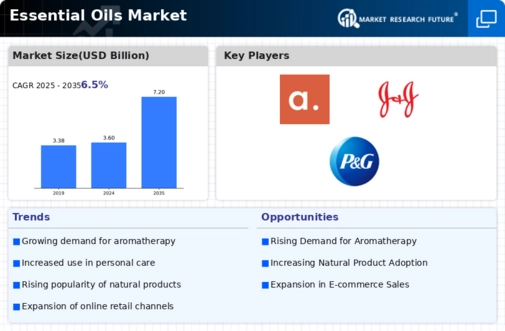Growing Health Consciousness
The increasing awareness of health and wellness among consumers appears to be a pivotal driver for the essential oils market. As individuals seek natural alternatives to synthetic products, the demand for essential oils, known for their therapeutic properties, is likely to rise. Reports indicate that the market could reach approximately $5 billion by 2027, reflecting a compound annual growth rate (CAGR) of around 8%. This trend is particularly pronounced in the United States, where consumers are gravitating towards holistic health solutions. The essential oils market is thus positioned to benefit from this shift, as more people incorporate these oils into their daily routines for stress relief, improved sleep, and overall well-being.
Rise of E-commerce Platforms
The proliferation of e-commerce platforms is transforming the way consumers access essential oils. With the convenience of online shopping, consumers can easily explore a wide range of products, leading to increased sales in the essential oils market. Data indicates that online sales channels could represent nearly 40% of the market by 2025, as consumers prefer the ease of purchasing from home. This shift is particularly relevant in the United States, where digital retailing continues to grow. The essential oils market is thus adapting to this trend, with brands enhancing their online presence and marketing strategies to capture the attention of tech-savvy consumers.
Growing Interest in DIY Products
The rising trend of do-it-yourself (DIY) products is significantly impacting the essential oils market. Consumers are increasingly interested in creating their own blends for personal use, whether for cleaning, skincare, or aromatherapy. This shift towards DIY solutions is likely to drive demand for essential oils, as individuals seek to customize their experiences. The essential oils market is witnessing a surge in sales of essential oils in smaller quantities, catering to this growing segment. Market analysis suggests that the DIY segment could contribute to a notable increase in overall market growth, as consumers embrace the creativity and personalization that these products offer.
Expansion of Aromatherapy Practices
The growing popularity of aromatherapy is significantly influencing the essential oils market. As more individuals recognize the mental and emotional benefits of aromatherapy, the demand for essential oils is expected to surge. The essential oils market is witnessing a notable increase in the use of these oils in spas, wellness centers, and even homes. Market data suggests that the aromatherapy segment could account for over 30% of the total essential oils market by 2026. This expansion is driven by a desire for relaxation and stress management, indicating a robust future for essential oils as consumers increasingly seek out these natural remedies.
Increased Use in Personal Care Products
The integration of essential oils into personal care products is emerging as a significant driver for the essential oils market. As consumers become more discerning about the ingredients in their skincare and beauty products, the demand for natural and organic formulations is likely to rise. Essential oils are increasingly being incorporated into lotions, shampoos, and cosmetics, appealing to health-conscious consumers. The essential oils market is projected to see a substantial increase in this segment, with estimates suggesting that personal care applications could account for over 25% of the market by 2026. This trend reflects a broader movement towards clean beauty and sustainable practices.














Leave a Comment